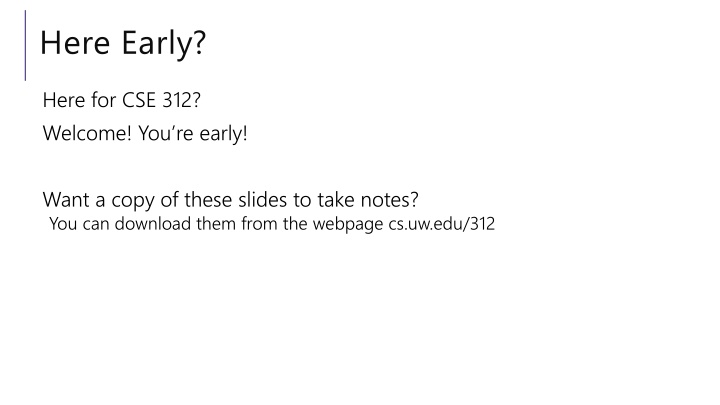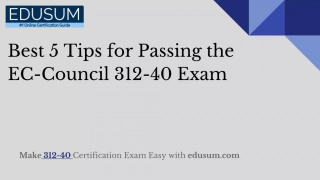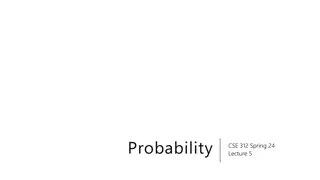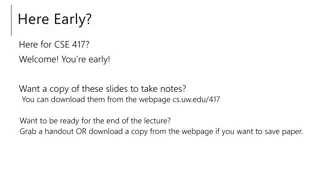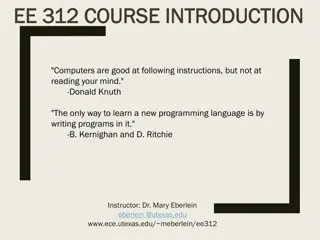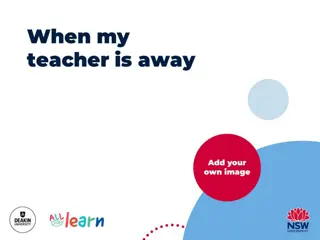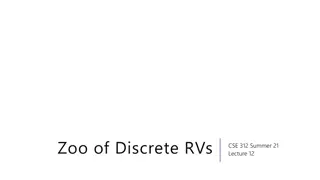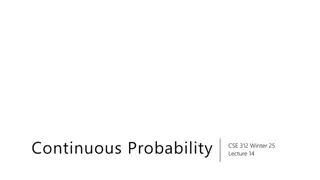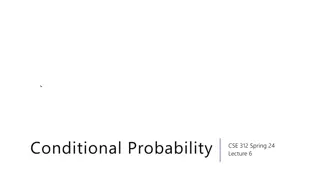CSE 312 Early Welcome Slides Notes
"Join CSE 312 early to get a head start! Access slides for Introduction and Counting, staff info, logistics, syllabus, and course requirements. Ready yourself for quizzes, homeworks, exams, and participatory sections. Stay informed via Ed for communication with TAs and instructor. Get set for an engaging learning experience in computer science!"
Download Presentation

Please find below an Image/Link to download the presentation.
The content on the website is provided AS IS for your information and personal use only. It may not be sold, licensed, or shared on other websites without obtaining consent from the author.If you encounter any issues during the download, it is possible that the publisher has removed the file from their server.
You are allowed to download the files provided on this website for personal or commercial use, subject to the condition that they are used lawfully. All files are the property of their respective owners.
The content on the website is provided AS IS for your information and personal use only. It may not be sold, licensed, or shared on other websites without obtaining consent from the author.
E N D
Presentation Transcript
Here Early? Here for CSE 312? Welcome! You re early! Want a copy of these slides to take notes? You can download them from the webpage cs.uw.edu/312
Introduction and Counting CSE 312 24Sp Lecture 1
Staff TAs Ameya Agrawal Yanxi Cui Jay Dharmadhikari Ariel Fu Alex Fu Saket Gollapudi Kirupa Gunaseelan Emma Huang Heon Jwa Alex Liu Di Mao Vlad Murad Gaurang Pendharkar Vinay Pritamani Sophie Lin Robertson Matthew Song Sam Tacheny Instructor: Robbie Weber Ph.D. from UW CSE in theory Fifth year as teaching faculty Email: rtweber2@cs.washington.edu
Logistics There are two lectures, MWF A lecture 10:30-11:20 (SMI 120), B lecture 1:30-2:20 (JHN 102) Both will be recorded, with recordings posted when possible. Try to attend your officially registered lecture, but you don t need permission to attend the other. The lectures should be nearly identical, but there will be small differences (e.g. more/fewer/different questions)
Logistics Sections meet on Thursdays (starting this week) Please go to your assigned section. If you can t make your assigned section one week, you can ask the TA(s) in charge of another for permission to join. Sections will not and give feedback without worrying about being recorded. Handouts and solutions will be posted. not be recorded we want you to be able to ask questions
Syllabus When in doubt, it s on the webpage: (or it will be soon ) https://courses.cs.washington.edu/courses/cse312/25wi/
Work Concept Checks (7.5%) Short quiz for each lecture on gradescope; identify misconceptions right away. Due the morning of the next lecture. First due date Friday Section Participation (5%) Go to section and work on problems there or (if you can t make it) do the corresponding problems on your own and email them to your TA. Approximately 7 Homeworks (50%) Mostly written problems, but a few programming questions. Two In-Section Quizzes (5%) Dates and topics will be announced well in-advance (likely Jan 30, Mar 6) Midterm (10%) Evening exam Wed Feb 19 Final exam (22.5%) Monday March 17 12:30-2:20 Combined exam for both sections
Communication Ed Discussion board will be our primary means of communication. Please check frequently. We ll send announcement emails via Ed. If you want to contact us: Private post on Ed (seen by TAs and Robbie, but not other students) Email Robbie Anonymous Feedback form on webpage
Collaboration Policy PLEASE collaborate! Please talk to each other and work with each other. (subject to the policy details on webpage)
What is This Class? We re going to learn fundamentals of probability theory. A beautiful beautiful and useful useful branch of mathematics. Applications in: Machine Learning Natural Language Processing Cryptography Error-Correcting Codes Data Structures Data Compression Complexity Theory Algorithm Design
Content Combinatorics (fancy counting) Permutations, combinations, inclusion-exclusion, pigeonhole principle Formal definitions for Probability Probability space, events, conditional probability, independence, expectation, variance Common patterns in probability Equations and inequalities, zoo of common random variables, tail bounds Continuous Probability pdf, cdf, sample distributions, central limit theorem, estimating probabilities Applications Across CS, but with some focus on ML.
Themes Precise mathematical communication Both reading and writing dense statements. Probability in the real world A mix of CS applications And some actual real life ones. Refine your intuition Most people have some base level feeling of what the chances of some event are. We re going to train you to have better gut feelings.
Why Counting? Sometimes useful for algorithm analysis. The easiest code to write for find X is try checking every spot where X could be Given an array, find a set of elements that sum to 0 Given an array, find a set of 2 elements that sum to 0 Gut check of we can brute force this or we can t is super useful. A building block toward probability theory What are the chances is usually calculated by = how many ways can I succeed+how many ways can I fail how many ways can I succeed
Remember sets? A set is an unordered unordered list of elements, ignoring repeats. {1,2,3}is a set. It s the same set as {2,1,3}. {1,1,2,3} is a very confusing way of writing the set {1,2,3}. The cardinality cardinality of a set is the number of elements in it. {1,2,3} has cardinality 3 = 3. 1,2,3
Counting Rules How many options do I have for dinner? I could go to Chili s where there are 3 meals I choose from, or I could go to Thaiger Room where there are 5 meals I choose from (and none of them are the same between the two). How many total choices? 3 + 5 = 8 Sum Rule: If you are choosing one thing between ? options in one group and ? in another group with no overlap, the total number of options is: ? + ?.
Counting Rules I m still hungry I decide to make a sandwich. My sandwiches are always: One of three types of bread (white, wheat, or sourdough). One of two spreads (mayo or mustard) One of four cheeses (American, cheddar, swiss, or Havarti) How many sandwiches can I make?
Sandwiches Step 1: choose one of the three breads. Step 2: regardless of step 1, choose one of the two spreads. Step 3: regardless of steps 1 and 2, choose one of the four cheeses. Sourdough White Wheat Mustard Mayo A H S C 3 2 4 = 24.
Counting Rules Sum Rule: If you are choosing one thing between ? options in one group and ? in another group with no overlap, the total number of options is: ? + ?. Product Rule: If you have a sequential process, where step ? has ?? options, step 2 has ??options, ,step ? has ?? options, and you choose one from each step, the total number of possibilities is ?? ?? ??
Applications of the product rule Remember Cartesian products? ? ? = { ?,? :? ?,? ?} 1,2 ?,?,? = { 1,? , 1,? , 1,? , 2,? , 2,? , 2,? } How big is ? ?? (i.e. what is |? ?|?) Step 1: choose the element from ?. Step 2: choose the element from ?. Total options: ? |?|
Power Sets ? ? = {?:? ?} ? 1,2,3 = { , 1 , 2 , 3 , 1,2 , 1,3 , 2,3 , 1,2,3 } How many subsets are there of ?, i.e. what is ? ? ?
Power Sets ? ? = {?:? ?} ? 1,2,3 = { , 1 , 2 , 3 , 1,2 , 1,3 , 2,3 , 1,2,3 } How many subsets are there of ?, i.e. what is ? ? ? If ? = {?1,?2, ,??} Step 1: is ?1 in the subset? Step 2: is ?2 in the subset? Step ? : is ?|?| in the subset? 2 2 2,|S| times, i.e., 2|?|.
Baseball Outfits The Husky baseball team has three hats (purple, black, gray) Three jerseys (pinstripe, purple, gold) And three pairs of pants (gray, white, black) How many outfits are there (consisting of one hat, jersey, and pair of pants) if the pinstripe jersey cannot be worn with gray pants, the purple jersey cannot be worn with white pants, and the gold jersey cannot be worn with black pants.
Baseball Outfits Step 1: 3 choices for hats. Step 2: 3 choices for jerseys Step 3:
Baseball Outfits Step 1: 3 choices for hats. Step 2: 3 choices for jerseys. Step 3: Regardless of which jersey we choose, we have 2 options for pants (even though there are three options overall). 3 3 2 = 18.
Assigning Books We have 5 books to split to 3 people (Alice, Bob, and Charlie) Every book goes to exactly one person, but each person could end up with no books (or all of them, or something in between). Alice 1 2 Bob 3 4 Charlie 5
Assigning Books We have 5 books to split to 3 people (Alice, Bob, and Charlie) Every book goes to exactly one person, but each person could end up with no books (or all of them, or something in between). Attempt 1: We re choosing subsets! Alice could get any of the 25= 32 subsets of the books. Bob could get any of the 25= 32 subsets of the books. Charlie could get any of the 25= 32 subsets of the books. Total is product of those three steps 32 32 32 = 32768
Activity Attempt 1: We re choosing subsets! Alice could get any of the 25= 32 subsets of the books. Bob could get any of the 25= 32 subsets of the books. Charlie could get any of the 25= 32 subsets of the books. Total is product of those three steps 32 32 32 = 32768
Activity Attempt 1: We re choosing subsets! Alice could get any of the 25= 32 subsets of the books. Bob could get any of the 25= 32 subsets of the books. Charlie could get any of the 25= 32 subsets of the books. Total is product of those three steps 32 32 32 = 32768 We overcounted! If Alice gets 1,2 , Bob can t get any subset, he can only get a subset of {3,4,5}. And Charlie s subset is just whatever is leftover after Alice and Bob get theirs
Fixing All The Books You could could List out all the options for Alice. For each of those (separately), list all the possible options for Bob and Charlie. Use the Summation rule to combine. ~OR~ you could come at the problem from a different angle.
Fixing All the Books Instead of figuring out which books Alice gets, choose book by book which person they go to. Step 1: Book 1 has 3 options (Alice, Bob, or Charlie). Step 2: Book 2 has 3 options (A, B, or C) Step 5: Book 5 has 3 options. Total: 35.
More sequence practice How many length 3 sequences are there consisting of distinct elements of {1,2,3}. .
Pause Questions in combinatorics and probability are often dense. A single word can totally change the answer. Does order matter or not? Are repeats allowed or not? What makes two things count the same or count as different ? Let s look for some keywords How many length 3 sequences are there consisting of distinct elements of {1,2,3}. . Sequences Sequences implies that order matters (1,2,3) and (2,1,3) are different. Distinct Distinct implies that you can t repeat elements (1,2,1) doesn t count. {1,2,3}is our universe our set of allowed elements.
More sequence practice How many length 3 sequences are there consisting of distinct elements of {1,2,3}. . Step 1: 3 options for the first element. Step 2: 2 (remaining) options for the second element. Step 3: 1 (remaining) option for the third element. 3 2 1.
Factorial That formula shows up a lot. The number of ways to permute (i.e. reorder , i.e. list without repeats ) ? elements is "? factorial ? factorial ?! = ? ? ? ? ? ? We only define ?! for natural numbers ?. As a convention, we define: 0! = 1.
Strings How many strings of length 5 are there over the alphabet {?,?,?, ,?}? (repeated characters allowed) How many binary strings of length ? are there?
Strings How many strings of length 5 are there over the alphabet {?,?,?, ,?}? (repeated characters allowed) 265 How many binary strings of length ? are there? 2?
